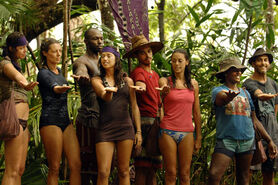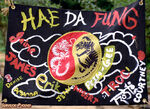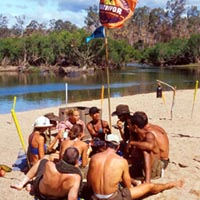The competing teams in Survivor are known as tribes. Commonly, there are two tribes in a season, but there have been instances where three or four may be active at the same time. A tribe can have anywhere from four to ten contestants at the beginning of the game.
Dividing Into Tribes
Most commonly, the tribes are divided by the producers before the game begins. However, there have been exceptions.
The Schoolyard Pick
- See also: Schoolyard Pick.
Some seasons have had the tribes selected by the contestants themselves. This is known as the "Schoolyard Pick".
- In Thailand and Gabon, the oldest male and female contestants were told that elders were given utmost respect in the location, and it was only fitting that they were the ones who will pick their tribe members.
- In Palau, the Schoolyard Pick was started by the winners of the first individual Immunity Challenge. The last two people left unpicked were eliminated from the game.
The Schoolyard style selection is not limited to just selecting starting tribes, but can be also used in a tribe switch (see below).
Tribes Preset by Production
In most early seasons, the castaways are divided into tribes semi-randomly:
- In Borneo, The Australian Outback, Africa, Marquesas, Pearl Islands, China, and Tocantins, the 16 contestants were divided into two tribes of eight, with four men and four women on each tribe.
- In All-Stars, the 18 contestants were divided into three tribes of six, with three men and three women on each tribe.
- In Guatemala, the 16 new contestants were divided into two tribes of eight, with four men and four women on each tribe. The two tribes were joined by a returning contestant from Palau, both of whom were already put into tribes.
- In Samoa, Cambodia, Game Changers, Ghost Island, Island of the Idols, and Winners at War, the 20 contestants were divided into two tribes of ten, with five men and five women on each tribe.
- In Redemption Island and South Pacific, the 16 new contestants were divided into two tribes of eight, with four men and four women on one tribe, and three men and five women on the other. The two returning contestants in each season (both men) had their tribes randomly drawn on Day 1.
- In Philippines, the 15 new contestants were divided into three tribes of five, with two men and three women on each tribe. The three tribes were joined by a returning male contestant who was evacuated from their previous season, each of whom were already put into tribes.
- In Edge of Extinction, the 14 new contestants were divided into two tribes of seven, with four men and three women on one tribe, and three men and four women on the other. They were joined by four returning players (two men and two women) who were already placed into tribes, one man and one woman each.
Tribes Divided by Theme
More common in recent years is to see tribes divided by a specific theme:
- In The Amazon, Vanuatu, and One World, tribes were separated by gender, known as the Battle of the Sexes twist. The Amazon had two tribes of eight, whereas the other two seasons had two tribes of nine.
- In Panama, the 16 contestants were divided into four tribes of four by age and gender (Older Men, Older Women, Younger Men, and Younger Women).
- In Cook Islands, the 20 contestants were divided into four tribes of five by ethnicity (African-American, Asian-American, Caucasian, and Hispanic). Each tribe had at least two men and at least two women.
- In Micronesia and Caramoan, the 20 contestants were divided into two tribes of ten: one tribe containing all-new players (the "Fans"), while the other has players from past seasons (the "Favorites"). Each tribe had five men and five women.
- In Heroes vs. Villains, the 20 contestants were divided into two tribes of ten by how they were generally perceived in their previous season(s), placing the contestants on either the Heroes or Villains tribe. Each tribe had five men and five women.
- In Nicaragua and Millennials vs. Gen X, the tribes were divided into two tribes of ten by age. Each tribe had five men and five women.
- In Blood vs. Water, the 20 contestants were divided into two tribes of ten, with five men and five women on each tribe. One tribe consisted of returning players (Galang) while the other tribe consisted of their loved ones (Tadhana).
- In Cagayan and Kaôh Rōng, 18 new castaways were divided into three tribes of six, based on a major trait or quality which they individually possessed, namely Brawn, Brains, and Beauty. Each tribe had three men and three women.
- In Worlds Apart, the 18 new contestants were divided into three tribes of six based on their professions and approaches to life: (White Collar, Blue Collar, and No Collar). Each tribe had three men and three women.
- In Heroes vs. Healers vs. Hustlers, the 18 new contestants were divided into three tribes of six based on the positive traits commonly associated with them: (Heroes, Healers, and Hustlers). Each tribe had three men and three women.
- In David vs. Goliath, the 20 new contestants were divided into two tribes of ten based on their degree of success in life: (David and Goliath). Each tribe had five men and five women.
Other
- Fiji was originally planned to start with 20 contestants, but one of them was unable to compete, leaving an odd number. Production rectified this by having one contestant divide the other 18 into two tribes of nine, each containing five men and four women; the picker would join the tribe that loses the first Immunity Challenge.
- San Juan del Sur repeated the Blood vs. Water division from the eponymous season, but with all new contestants. Originally planned to consist of 20 contestants, with two tribes of ten (each five men and five women), the numbers were reduced to 18 contestants on two tribes of nine (each five men and four women) when one pair was unable to compete.
Names and Identification
Starting tribes are given unique names (usually based on local language, culture, or history) and identifying colors which are used on tribe flags, challenge props, on-screen text, and various other items. Each player is given a buff, an elastic ring of cloth generally adorned with the logo for the current season, that can be worn as an armband, headband, tube top, miniskirt, mask, or a bow tie. Players are required to wear the buff with the color of their tribe in a visible location at all times only being allowed to take their buffs off when Jeff Probst tells them to, allowing the audience to identify tribal affiliation.
Tribe Switch
- See also: Tribe Switch.

The Malakal tribe of the Favorites drawing stones in preparation for the tribe switch.
The tribe switch is the very first Survivor twist. Jeff Probst asks the contestants to drop their buffs, signaling there will be a change in the nature and personal makeup of the tribes. In a tribe switch, the contestants will either end up at their original tribe or they will be swapped into another. They must give up their old buff and must don a new one. If there is a switch, it occurs before the merge, commonly catching players off-guard. As seen in Survivor: All-Stars and Survivor: Gabon, the switch twist may sometimes happen even when there are only ten players left, leading the remaining players to believe that a merge is coming. The logic of the switch is that the relationships from their first tribe will be tested in their new tribe, and will create additional possibilities when the tribes finally merge. Oftentimes, players who were not successful in their original tribe use the switch as an opportunity to create new bonds, and potentially last longer in the competition.
Mutiny
- See also: Mutiny (twist).

Candice turning back from Aitutaki and to rejoin Rarotonga. Jonathan will soon follow.
The mutiny is a variation of the tribe switch. This twist allows players to change tribes at will. Like a traditional swap, the "mutineer" must surrender his/her old buff and will be given the same colored buff as his/her new tribe. The mutiny is a rare twist, as it was unpopular among players (as this is deemed a big, bold move for many, thus doing so will be very risky). Four seasons have offered a chance to mutiny, though from those four times, the offer was accepted only once.
- In Survivor: Thailand, the first ever mutiny was offered at the Survivor Auction. No one accepted the offer.
- In Survivor: Pearl Islands, a mutiny was offered, but was unanimously declined and not televised.[citation needed]
- Survivor: Cook Islands marked the only time the mutiny offer was accepted. Candice Woodcock, a former Rarotonga member, felt uneasy since transferring to the Aitutaki tribe. When the mutiny was offered, she turned on her tribe and jumped back. Jonathan Penner followed suit, leaving Aitutaki with four members, while Rarotonga's numbers increased to eight.
- In Survivor: Tocantins, the mutiny was a sub-twist of Exile Island. Both banished castaways must pick one of two bottles. One bottle contains a clue of the whereabouts of the Hidden Immunity Idol and a choice to join the other camp, while the second one holds nothing. No one accepted the offer.
Tribe Dissolves
Another variant of the tribe switch is the "dissolve." Usually happens in a season with more than two tribes at a time, tribe(s) will be permanently disbanded, spreading its old members into the remaining tribes. Like in a traditional swap, members of a dissolved tribe must surrender their old buff and must join their new tribe.
- Before the fourth Reward Challenge in All-Stars commenced, a twist was revealed that only two of the three tribes will exist after the challenge, as the losing tribe will be dissolved and absorbed by the two winning tribes. Saboga wrote Survivor history as the very first tribe to retire before the merge. Ethan Zohn and Jerri Manthey were absorbed by Mogo Mogo, while Rupert Boneham and Jenna Lewis transferred to Chapera.
- In Palau, Ulong was conquered by its rival, Koror, transferring its last member to the opposing tribe; this makes it the only season not to have a merge.
- In Panama and Cook Islands, two of the four tribes were dissolved, and all the players were assigned to one of the two remaining tribes.
- In Philippines, Matsing lost the first four Immunity Challenges, dwindling their numbers from 6 to 2. The tribe was dissolved; Malcolm Freberg was absorbed by Tandang, and Denise Stapley by Kalabaw.
- In Cagayan, Luzon lost three of the first four Immunity Challenges, causing their numbers to drop to 3. The tribe was dissolved and the remaining fourteen castaways were shuffled between the remaining Aparri and Solana tribes. All three remaining Luzon members, Spencer Bledsoe, Tasha Fox, and Kass McQuillen, were placed on the new Aparri tribe.
- In Worlds Apart, the "White Collar" tribe, Masaya, was dissolved and the remaining fourteen castaways were shuffled between the remaining Escameca and Nagarote tribes.
- In Cambodia, the Angkor tribe was formed on Day 7 and then dissolved back into the remaining Ta Keo and Bayon tribes on Day 14.
- In Kaôh Rōng, To Tang lost three of the first four Immunity Challenges, dwindling the tribe from 6 to 3. The thirteen remaining castaways were shuffled between the remaining Chan Loh and Gondol tribes. To Tang was dissolved; Cydney Gillon and Kyle Jason were placed on Chan Loh, while Scot Pollard was placed on Gondol.
- In Game Changers, the Tavua tribe was formed on Day 7 and then dissolved back into the remaining Mana and Nuku tribes on Day 14.
Tribe Types
Starting Tribes

Each Survivor season starts with 16 to 20 contestants (dubbed as the "castaways") stranded in a remote location and will be left there for the next 39 days (42 in Survivor: The Australian Outback). The castaways will be then equally divided into teams "tribes". These tribes then will be sent out to separate camps identified by a colored tribe banner. Both camps are far apart from each other and they have an equal distance from the challenge areas, the production team's encampment and the Tribal Council set (example, if tribe A has a 1-mile distance from Tribal Council, so does tribe B; see the Camp article for more information). The resources of both camps (food and water) can be either equally found or compromising (example, tribe A's camp may have a better water source, but finding food would be difficult, while tribe B will have the opposite). From there on out, the contestants must fend for themselves in all aspects of survival (foraging for food, creating shelter, fishing, etc.). Tribes will also be given meager supplies (with a machete, water canteens, and a pot as staples), depending on the season (there are seasons that that have limited food rations, but there are some seasons that they were given only the staples). Earlier seasons allowed castaways to have a "luxury item" (a piece of home), though some seasons pit the players into the game without preparation (merely making them compete with only the clothes they are currently wearing). In Palau, running shoes were also provided for the contestants.
Merged Tribe
- See also: Merge.

The newly painted flag of the merged Hae Da Fung tribe (China).

The Barramundi tribe (Australia), newly merged and feasting.
The merged tribe is composed of the remaining members of the two starting tribes. Whereas the starting tribes are named by the producers, the new tribe will be usually named by the castaways themselves.
They will be given a new, blank tribe flag and buffs with some paint to decorate the new flag. Usually, a feast is held at the new tribe's camp to celebrate the event. The merged tribe camp is generally the better of the two former tribe camps, but in rare cases (The Australian Outback, The Amazon, and Redemption Island) they will be relocated to a new beach. Reward Challenges may still be team-based (depending on the number of remaining players), but Immunity Challenges will be conducted on a strictly individual basis.
Auxiliary Tribe

Angkor, the first Auxiliary Tribe.
An auxiliary tribe is a third tribe introduced early in or midway through the pre-merge phase of the game through a Tribe Switch. The castaways of these tribes are usually relocated to a new beach where they must again set camp from scratch.
Ghost Tribe

The infamous Outcast tribe of Survivor: Pearl Islands.
The only ghost tribe that appeared in the show was the infamous Outcasts in Survivor: Pearl Islands, where the six eliminated players returned for a second chance to play the game.
Tribe Colors Per Season
| Key | |
|---|---|
| Bold Text | Merged Tribe |
| Italic Text | Dissolved Tribe |
| Underlined Text | Auxillary or "Ghost" Tribe |
| Regular Text | Lasted until Merge |
Survivor (U.S.)
Australian Survivor
| Survivor (Australia) Tribe Colors Per Season | |||||||||
|---|---|---|---|---|---|---|---|---|---|
| Orange | Yellow/Gold | Green | Blue/Teal | Red | Magenta | Pink | Black | Gray | |
| Australian Survivor (2002) | Kadina | Tipara | Aurora | ||||||
| Celebrity Survivor Australia | Kakula | Moso | Tanna | ||||||
| Australian Survivor (2016) | Vavau | Saanapu | Aganoa | Fia Fia | |||||
| Australian Survivor (2017) | Asaga | Samatau | Asatoa | ||||||
| Champions v Contenders (2018) | Champions | Contenders | Koro Savu | ||||||
| Champions v Contenders (2019) | Champions | Contenders | Soli Bula | ||||||
| All Stars | Vakama | Mokuta | Kalo Kalo | ||||||
| Total Uses: | 1 | 2 | 2 | 6 | 3 | 1 | 1 | 5 | 1 |
Survivor New Zealand
| Survivor (New Zealand) Tribe Colors Per Season | |||||
|---|---|---|---|---|---|
| Orange | Yellow/Gold | Blue/Teal | Purple | Black | |
| Nicaragua | Mogotón | Hermosa | Casar | ||
| Thailand | Khangkhaw | Chani | Phsan | ||
| Total Uses: | 1 | 1 | 1 | 2 | 1 |
Survivor South Africa
| Survivor (South Africa) Tribe Colors Per Season | ||||||||
|---|---|---|---|---|---|---|---|---|
| Orange | Yellow/Gold | Blue/Teal | Red | Magenta | Purple | Black | White | |
| Panama | Burba | Aguila | Rana | |||||
| Malaysia | Bajau | Iban | Empu | |||||
| Santa Carolina | Timbila | Chibudu | Kululama | |||||
| Maldives | Eku | Raituhn | Goma | |||||
| Champions | Juara | Salvation | Utara | Selatan | ||||
| Philippines | Visayas | Mindanao | Luzon | Araw | ||||
| Island of Secrets | Manumalo | Laumei | Sa'ula | Ta'alo | ||||
| Immunity Island | ||||||||
| Total Uses: | 2 | 5 | 6 | 5 | 1 | 2 | 2 | 1 |
Trivia
![]() This section is empty. You can help by adding to it.
This section is empty. You can help by adding to it.
